With the year 2020 coming to an end, I bring you the list for public holidays for 2021. I will also give a brief primer on what do these holidays mean! Learn interesting tidbits and unknown facts about Holi, Ugadi, et all. Along with enjoying the year-end festivities, it’s time for companies to start planning their annual holiday calendar as per the leave policy of the company for their employees.
To make this process easy for you, I wanted to share a list which has all the holidays celebrated around the year across India. In this blog, I will cover the state-wise holiday list that will help you create the best calendar for your organization. Today, I will be covering the following:
- What do Public Holidays mean?
- What are the mandatory national public holidays?
- Holi
- Ugadi
- Eid-ul-Fitr
- Onam
- Ganesh Chaturthi
- Vijayadashami
- Deepavali
- Guru Nanak Jayanti
- Christmas
- Andhra Pradesh Public holidays 2021
- Maharashtra Public holidays 2021
- Karnataka Public holidays 2021
- Tamil Nadu Public holidays 2021
- Telangana Public holidays 2021
What do Public Holidays mean?
A public holiday is a holiday generally established by law and is usually a non-working day during the year. The holidays are declared under the Negotiable Instruments Act, 1981. They are usually applicable to Government departments more particularly to banks.
There is also no uniform definition of a public holiday. A public holiday can be also set in different ways. It can be fixed, where the holiday occurs on the same date every year irrespective of the weekday it falls on. It can be moveable, where the date varies from year to year depending on other factors such as the cycle of the moon.
Public holiday is a holiday which is observed in a public office and includes a national holiday. In government sector there is no such national holiday but they have closed holidays and restricted holidays. The former are the days on which the office will remain closed and the latter are the days on which the office will be open but some of the employees will enjoy holiday. Since the government offices are meant for the general public and as such the government has an obligation to inform the public that the office will remain closed on certain days and hence these holidays are called public holidays.
What are the mandatory national public holidays?
Most countries have a designated national day. This holiday usually celebrates something notable in the creation of that country, such as its independence or signing of the constitution. Some countries may have more than one national day, such as India, which has three.
National and Festival Holiday Act, which is applicable to all establishments in the country, irrespective of under which law it is formed it is mandatory to grant leave on following 3 days:
- 26th January (Republic Day).
- 15th August (Independence Day).
- 2nd October (Gandhi Jayanti).
For rest of the festival holidays the declaration depends on the discretion of the concerned States and establishments. Number of festive holidays can differ from state to state.
Republic Day (26 January)

Republic Day has been celebrated every year in India on January 26, since 1950; to honor the date on which the Constitution of India came into effect.
India was a colony of the British for over 200 years and became independent from the rule of the British following the Indian independence movement. While India became independent on August 14, 1947, it still didn’t have a permanent constitution, and Indian laws were based on a modified version of the British established, Government of India Act 1935.
The draft of the constitution was submitted to the Indian Constituent Assembly on 4 November 1947. Over the course of 166 days, that were spread over two years, the 308 members of the Assembly met in sessions that were open to the public and made some modifications. Finally, on January 24, 1950, the Assembly members signed two handwritten copies of the Constitution, one in English and one in Hindi. And two days later history was made.
On that day began Dr. Rajendra Prasad’s first term of office as President of the Indian Union. The Constituent Assembly became the Parliament of India under the transitional provisions of the new Constitution.
January 26 is celebrated to commemorate the Indian Constitution replacing the Government of India Act (1935) as the governing document of India. And now it is celebrated across India with a lot of fervor.
Independence Day (15 August)
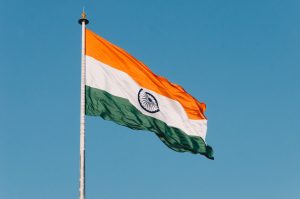
Independence Day, in India is a national holiday that is celebrated annually on August 15. It marks the end of British rule in 1947 and also the establishment of a free and independent Indian nation. It also marks the anniversary of the partition of the subcontinent into two countries; India and Pakistan, which occurred at midnight on August 14–15, 1947. (In Pakistan, Independence Day is celebrated on August 14.).
Independence Day is marked throughout India with flag-raising ceremonies, drills, and also the singing of the Indian national anthem. Additionally, various cultural programs are conducted in the state capitals. After the prime minister also participates in the flag-raising ceremony at the Red Fort historic monument in Old Delhi; a parade also ensues with members of the armed forces and police.
Gandhi Jayanti (2 October)
Holi
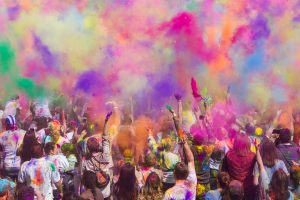
Holi is considered as one of the most revered and celebrated festivals of India and it is also celebrated in almost every part of the country. The great Indian festival also lasts for a day and a night, which starts in the evening of Purnima or the Full Moon Day in the month of Falgun. It is celebrated with the name Holika Dahan or Choti Holi on first evening of the festival and the following day is called Holi. In different parts of the country it is also known with different names.
History of Holi
The origin of Holi is believed to be before the birth of Christ. Legend goes that Lord Vishnu also had assassinated the younger brother of the demon lord, Hiranyakashipu. Apart from also avenging his brother’s death; the demon king had also the ulterior motive of ruling the heaven, the earth, and the underworld by defeating Vishnu. Powered by a boon granted to him, Hiranyakashipu also thought he had become invincible.
On his orders, his whole state also started praying him, dismissing the gods. But also his son, Prahalad, maintained his deity to be none but Vishnu. Angered, the tyrant king also decided to kill Prahalad with the help of Holika, Hiranyakashipu’s sister, who was immune to fire. A pyre was lit and Holika also sat on it, clutching Prahalad. But Prahalad also emerged out of the fire unscathed, whereas Holika burned to ashes. Hiranyakashipu, too, was also eventually killed by Vishnu. Even today, the story of Holika is also re-enacted by actors on Holi. Bonfires across the country are also lit up to celebrate the burning away of the evil spirits.
Facts about Holi
- The vibrancy of colors is also something that brings in a lot of positivity in our lives and Holi being the festival of colors is actually a day worth rejoicing.
- Holi is a famous Hindu festival that is also celebrated in every part of India with utmost joy and enthusiasm.
- The ritual starts by also lighting up the bonfire one day before the day of Holi. And this process also symbolizes the triumph of good over the bad.
- On the day of Holi people play with colors with their friends and families also and in evening they show love and respect to their close ones with Abeer.
Ugadi
Regions where Ugadi is celebrated
Ugadi, a major festival in Karnataka (also Yugadi), Telangana, Andhra Pradesh, and Maharashtra (Gudi Padwa) , is celebrated as the New Year’s Day, as per the Hindu calendar.
History of Ugadi
As per Hindu mythology, it was on this day that Lord Brahma created the universe. He then went on to create days, weeks, months, and years. So, Ugadi is believed to be the first day of the creation of the universe.
Facts about Ugadi
- The word “Ugadi” is a combination of two words— “Yuga” (age) and “Adi” (beginning).
- An auspicious occasion, the day is celebrated with much pomp and gusto.
- People from every sphere of the society enjoy the day by wearing new clothes and gorging on delicious delicacies.
- Prayers are offered in temples to welcome the new year while people clean their homes and decorate them with Rangolis—a traditional way to decorate floors by creating various patterns with colored rice or flower petals.
Eid-ul-Fitr
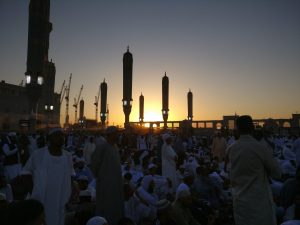
Eid-al-Fitr (Eid al-Fitr, Eid ul-Fitr, Id-Ul-Fitr, Eid) is the first day of the Islamic month of Shawwal. It marks the end of Ramadan, which is a month of fasting and prayer. Many Muslims attend communal prayers, listen to a khutba (sermon) and give zakat al-fitr (charity in the form of food) during Eid al-Fitr.
History of Eid-ul-Fitr
Eid-ul-Fitr was also started by Islamic Prophet Muhammad. It is believed that Prophet Muhammad got the first revelation of the Holy Quran during the month of Ramadan. Eid Al Fitr then marked the end of fasting from dawn to dusk during Ramadan and the beginning of the Shawwal month. Eid Al Fitr is also celebrated to pay respect to Allah for providing the strength and endurance during the month long fasting rituals.
Facts about Eid-ul-Fitr
- Muslims across the globe start Eid-ul-Fitr celebrations by taking part in prayers which is followed by a sermon soon after dawn.
- The day proceeds with people getting ready, wearing new clothes and also exchanging greetings and sweets.
- Children receive gifts and also money from elders.
- The day is incomplete without the preparation of a variety of dishes including Biryani, Haleem, kebabs and also a sweet dish like Seviyan.
- As one of the five pillars of Islam, Zakat or giving of alms to the poor is also practiced on Eid.
Onam
Onam, a harvest festival that also falls in the months of August/September annually. It is celebrated across India and the world, and is also the main festival among Keralites. According to the Malayali calendar month of Chingam, the festival also falls on the 22nd Nakshatra Thiruvonam, and marks the beginning of the Malayalam year, called Kolla Varsham.
History of Onam
According to Vaishnava mythology, King Mahabali also defeated the Gods and began ruling over all three worlds. King Mahabali was a also demon king who belonged to the Asura tribe. The kind-hearted king was also much-loved by the people. The Gods also got insecure of King Mahabali’s popularity and Lord Vishnu to step in and help contain Mahabali.
Lord Vishnu also took on his fifth avatar, in the form of the Brahmin dwarf Vamana, and paid a visit to King Mahabali. King Mahabali asked Vamana what he also wished for, to which Vamana responded, “three pieces of land”. When Vamana was granted his wish, he grew in size and in his first and second pace respectively, he covered the sky, and then the netherworld.
When Lord Vishnu was about to take his third pace, King Mahabali offered his own head to the God. This act impressed Lord Vishnu so much that he granted Mahabali the right to visit his kingdom and people every year during Onam festivities.
Facts about Onam
During the ten-day festivities, devotees bathe, offer prayers, wear traditional clothes; women of the household wear a white and gold saree called the Kasavu saree – participate in dance performances, draw flower rangolis called pookkalam and cook traditional feasts called sadya. Sadya is served on banana leaves during Onam.
The 10-day festivities also see people participating in various activities like:
- Boat races called Vallam Kali.
- Tiger dances called Pulikali.
- worship the God or Onathappan.
- Tug of War.
- Thumbi Thullal or women’s dance ritual.
- Mask dance or Kummattikali.
- Onathallu or martial arts.
- Onavillu/music.
- Onapottan (costumes).
- Folk songs among other fun activities.
Ganesh Chaturthi
Ganesh Chaturthi is also celebrated annually to mark the birth of Lord Ganesh, the God of new beginnings and a fresh start. The festival falls in the month of Bhadra, according to the Hindu calendar and in August/September also according to the Gregorian calendar. Lord Ganesh is also considered to be a symbol of wisdom, writing, travel, commerce and good fortune. He is also addressed as Gajanan, Ganesh, Gajanand that are among his 108 names. It is one of the public holidays 2021.
History of Ganesh Chaturthi
Legend tells the tale of Goddess Parvati who made baby Ganesh using sandalwood paste and asked him to guard the entrance while she took a bath. When Lord Shiva wanted to enter, Ganesh would not even allow him to pass through. Lord Shiva, enraged by this, severed the child’s head. When Goddess Parvati realized what had happened, she was overwhelmed and heartbroken. This is when Lord Shiva promised that he would bring baby Ganesh back to life. He went on to instruct his followers (ganas) to search for the head of the first living creature they could find to replace on Ganesh’s body. However, the ganas could only find a baby elephant’s head. That is how Lord Ganesh came back to life with the head of an elephant. Lord Shiva named him the leader of the ganas, or Ganapati.
Facts about Ganesh Chaturthi
- The excitement for this 10-day long festival begins weeks before Ganesh Chaturthi, with several people making clay idols of Lord Ganesha and painting them.
- Originally, Ganesh Chaturthi is known to be celebrated in a large way in Maharashtra and Andhra Pradesh, but the festival and festivities have spread far and wide, with devotees celebrating in other parts of the country with equal fervour.
- The festival begins with Pranapratishhtha, which consists of the chanting of mantras by a priest. Offerings which are known to be loved by Lord Ganesh are placed infront of his idol. These include modak, shrikhand, payasam, coconut rice, motichoor laddoo and other sweets.
- Devotees throng to temples and special pandals set up for Ganesh Chaturthi to pay their respects to the Lord Ganesha. People also sometimes choose to bring Ganpati home ahead of the festival and host him for the 10-day festivities.
- On the tenth day, Lord Ganesh’s statue is immersed in water, known as Ganpati Visarjan. Devotees chant Ganapati Bappa Morya, paying respect to him as he is seen off, taking all our worries away and leaving blessings behind.
Vijayadashami
This day is marks the journey of Goddess Durga back to Kailash also after ten days of stay at her parent’s house on Earth. Every year, Mother Durga also visits her paternal house along with her four children—Lakshmi, Saraswati, Kartikeya and Ganesha. It is one of the public holidays 2021.
She is also accompanied by two ‘sakhis’ or friends—Jaya and Vijaya. Vijaya Dashami also marks the victory of the Pandavas over the Kauravas in Mahabharata and the end of their exile. In India, it also marks the beginning of the harvest festival.
History of Vijayadashami
It marks the day on which Lord Rama achieved victory over Ravana, the ten headed demon king of Lanka. This day is also symbolic of the end of Mahishasur, the king of demons whon was killed by Goddess Durga on this day.
According to mythology, Durga was created by the Gods by pooling in their spiritual powers as they wanted to create ‘shakti’ that was ultimate and could annihilate Mahishasur.
Facts about Vijayadashami
- Vijaya Dashami is one of the important days of Durga Puja. Durga Puja is a Hindu festival in South Asia that celebrates the worship of the goddess Durga. Durga Puja celebrates the ten-armed mother goddess, and her victory over the evil buffalo demon Mahishasura.
- The world was under threat from the evil buffalo demon Mahishasura, that no man or god could defeat. To vanquish the demon, Durga emerged from the collective energies of all the gods. Each of her ten arms brandished the deadliest weapon of each god.
- Also known as Dashain or Tenth day of Navratri or Durgotsav, Vijaya Dashami commemorates the day that Durga appeared riding a lion to slay the Mahisasura. Statutes of Durga are paraded through the streets, then immersed in water.
Deepavali
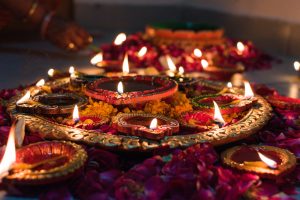
Diwali, or Deepavali, is India’s biggest and most important holiday of the year. The festival gets its name from the row (avali) of clay lamps (deepa) that Indians light outside their homes to symbolize the inner light that protects from spiritual darkness. Over the centuries, Diwali has become a national festival that’s also enjoyed by non-Hindu communities.
History of Deepavali
Diwali is called the Festival of Lights and is celebrated to honor Rama-chandra, the seventh avatar (incarnation of the god Vishnu). It is believed that on this day Rama returned to his people after 14 years of exile during which he fought and won a battle against the demons and the demon king, Ravana. People lit their houses to celebrate his victory over evil (light over darkness). The goddess of happiness and good fortune, Lakshmi, also figures into the celebration. It is believed that she roams the Earth on this day and enters the house that is pure, clean, and bright.
Facts about Deepavali
- The Diwali celebration in India takes place when the monsoon season ends and the weather is mild and pleasant.
- People try to pay off their old debts, make or buy new clothes and thoroughly clean their houses as part of the festival preparations.
- House exteriors are whitewashed and sometimes decorated with designs drawn in white rice flour and filled in with color.
- Buildings are traditionally illuminated with oil-burning bowls called deepak lights, or more recently, with strings of artificial lights.
- People spend time with their friends and family.
Guru Nanak Jayanti
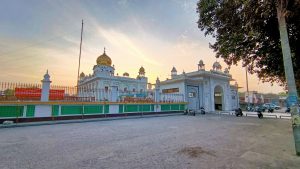
Guru Nanak Jayanti or Prakash Utsav is also one of the most auspicious and significant days in Sikhism. The day marks the birth anniversary of Guru Nanak Dev, the founder of the religion of Sikhism and also the first of the Sikh Gurus. Born in Rai-Bhoi-di Talwandi present-day Shekhupura District also in Pakistan. This place is also popularly known as Nanakana Sahib.
As per the Hindu lunar calendar, it is also one of the holiest festivals for the Sikh community which is celebrated worldwide every year on the full moon day of the month Kartik, which usually falls in November in the western calendar.
History of Guru Nanak Jayanti
Guru Nanak Jayanti, the foremost of all the Gurupurabs or anniversaries of the 10 Sikh Gurus, is also the birth anniversary of Guru Nanak Dev, the founder of the Sikh faith, who ushered in a new wave in religion. The first of the 10 Sikh Gurus, Guru Nanak was born also in 1469 at Talwandi, near Lahore.
Facts about Guru Nanak Jayanti
- The celebration of Guru Nanak Dev begins 15 days before his birth anniversary.
- People start doing pheris, 15 days before the celebration. Two days ahead of Gurpurab, Akhand Path or a 48-hour non-stop reading of Guru Granth Sahib, the holy book of the Sikhs is held in the Gurdwaras. A day before Gurpurab, Nagar Kirtan is organised in communities.
- On the main day of the festival arrives, the celebrations can sometimes begin as early as 3 am. After the morning prayers, Langars or Grand Feasts are organized for everyone.
Christmas

Christmas is celebrated on December 25 and is both a sacred religious holiday and a worldwide cultural and commercial phenomenon. For two millennia, people around the world have been observing it with traditions and practices that are both religious and secular in nature.
History of Christmas
Centuries before the arrival of the man called Jesus, early Europeans celebrated light and birth in the darkest days of winter. Many peoples rejoiced during the winter solstice, when the worst of the winter was behind them and they could look forward to longer days and extended hours of sunlight.
Christians celebrate Christmas Day as the anniversary of the birth of Jesus of Nazareth, a spiritual leader whose teachings form the basis of their religion. Popular customs include exchanging gifts, decorating Christmas trees, attending church, sharing meals with family and friends and, of course, waiting for Santa Claus to arrive.
Facts about Christmas
- Many homes have Christmas trees and other decorations in the weeks leading to Christmas Day. Some workplaces hold Christmas parties prior to December 25. Festive activities include exchanging presents, singing Christmas songs, going to parties.
- It’s a special time when children get presents from family, friends and Santa Claus, or Father Christmas. Christmas cards are also given or sent out prior to Christmas Day.
- For some, Christmas is an exclusive family affair, while others invite friends to a Christmas buffet or pot luck meal. Churches have special services and may include a crèche or miniature Nativity scene.
Andhra Pradesh Public holidays 2021

Date |
Day |
Holiday |
| Jan 13 | Wednesday | Bhogi |
| Jan 14 | Thursday | Makara Sankranti |
| Jan 15 | Friday | Kanuma |
| Jan 26 | Tuesday | Republic Day |
| Mar 11 | Thursday | Maha Sivaratri |
| Mar 29 | Monday | Holi, Shab-E-Barath |
| Apr 2 | Friday | Good Friday |
| Apr 5 | Monday | Babu Jagjivan Ram’s Birthday |
| Apr 13 | Tuesday | Ugadi |
| Apr 14 | Wednesday | Dr.B.R. Ambedkar’s Birthday |
| Apr 21 | Wednesday | Sri Rama Navami |
| May 14 | Friday | Ramzan (Eid-ul-Fitr) |
| Jul 21 | Wednesday | Bakrid (Eid-ul-Azha) |
| Aug 15 | Sunday | Independence Day |
| Aug 19 | Thursday | Moharrum |
| Aug 30 | Monday | Sri Krishna Astami |
| Sep 10 | Friday | Vinayaka Chavithi |
| Oct 2 | Saturday | Mahatma Gandhi Jayanthi |
| Oct 13 | Wednesday | Durgastami |
| Oct 15 | Friday | Vijayadasami |
| Oct 20 | Wednesday | Eid Miladun Nabi (Birthday of Prophet Mohammad) |
| Nov 4 | Thursday | Deepavali |
| Dec 25 | Saturday | Christmas |
Maharashtra Public holidays 2021
Date |
Day |
Holiday |
|---|---|---|
| 26 Jan | Tuesday | Republic Day |
| 19 Feb | Friday | Chhatrapati Shivaji Maharaj Jayanti |
| 11 Mar | Thursday | Maha Shivaratri |
| 29 Mar | Monday | Holi |
| 2 Apr | Friday | Good Friday |
| 13 Apr | Tuesday | Gudi Padwa |
| 14 Apr | Wednesday | Dr. Ambedkar Jayanti |
| 21 Apr | Wednesday | Ram Navami |
| 25 Apr | Sunday | Mahavir Jayanti |
| 1 May | Saturday | Maharashtra Day |
| 13 May | Thursday | Idul Fitr |
| 26 May | Wednesday | Buddha Purnima |
| 20 Jul | Tuesday | Bakrid / Eid al Adha |
| 15 Aug | Sunday | Independence Day |
| 17 Aug | Tuesday | Parsi New Year |
| 19 Aug | Thursday | Muharram |
| 10 Sep | Friday | Ganesh Chaturthi |
| 2 Oct | Saturday | Gandhi Jayanti |
| 15 Oct | Friday | Vijaya Dashami |
| 19 Oct | Tuesday | Eid e Milad |
| 4 Nov | Thursday | Diwali |
| 5 Nov | Friday | Deepavali Holiday |
| 19 Nov | Friday | Guru Nanak Jayanti |
| 25 Dec | Saturday | Christmas Day |
Karnataka Public holidays 2021
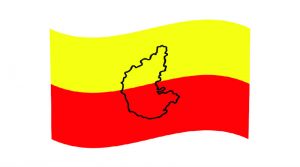
Date |
Day |
Holiday |
| Jan 14 | Thursday | Makara Sankranti |
| Jan 26 | Tuesday | Republic Day |
| Mar 11 | Thursday | Maha Shivaratri |
| Apr 2 | Friday | Good Friday |
| Apr 13 | Tuesday | Ugadi |
| Apr 14 | Wednesday | Ambedkar Jayanti |
| Apr 25 | Sunday | Mahavir Jayanti |
| May 1 | Saturday | May Day |
| May 14 | Friday | Basava Jayanti & Ramzan |
| Jul 21 | Tuesday | Bakrid |
| Aug 15 | Sunday | Independence Day |
| Aug 20 | Thursday | Muharram |
| Sep 10 | Friday | Ganesh Chaturthi |
| Oct 2 | Saturday | Gandhi Jayanti |
| Oct 6 | Wednesday | Mahalaya Amavasye |
| Oct 14 | Thursday | Maha Navami |
| Oct 15 | Friday | Vijaya Dashami |
| Oct 19 | Tuesday | Id Milad |
| Oct 20 | Wednesday | Maharishi Valmiki Jayanti |
| Nov 1 | Monday | Kannada Rajyothsava |
| Nov 3 | Wednesday | Naraka Chaturdashi |
| Nov 5 | Friday | Deepavali |
| Nov 22 | Monday | Kanakadasa Jayanti |
| Dec 25 | Saturday | Christmas |
Tamil Nadu Public holidays 2021

Date |
Day |
Holiday |
| Jan 1 | Friday | New Year’s Day |
| Jan 14 | Thursday | Pongal |
| Jan 15 | Friday | Thiruvalluvar Day |
| Jan 16 | Saturday | Uzhavar Thirunal |
| Jan 26 | Tuesday | Republic Day |
| Apr 1 | Thursday | Annual closing of bank accounts |
| Apr 2 | Friday | Good Friday |
| Apr 13 | Tuesday | Telugu New Year’s Day |
| Apr 14 | Wednesday | Tamil New year’s Day and Dr. B.R. Ambedkar’s Birthday |
| Apr 25 | Sunday | Mahavir Jayanthi |
| May 1 | Saturday | May Day |
| May 14 | Friday | Ramzan (idu’l Fitr) |
| Jul 21 | Wednesday | Bakrid (Idul Azha) |
| Aug 15 | Sunday | Independence Day |
| Aug 20 | Friday | Muharram |
| Aug 30 | Monday | Krishna Jayanthi |
| Sep 10 | Friday | Vinayakar Chathurthi |
| Oct 2 | Saturday | Ganthi Jayanthi |
| Oct 14 | Thursday | Ayutha Pooja |
| Oct 15 | Friday | Vijaya Dasami |
| Oct 19 | Tuesday | Milad-un-Nabi |
| Nov 4 | Thursday | Deepavali |
| Dec 25 | Saturday | Christmas |
Telangana Public holidays 2021
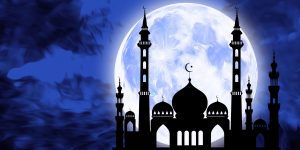
Date |
Day |
Holiday |
| Jan 1 | Friday | New Year Day |
| Jan 13 | Wednesday | Bhogi |
| Jan 14 | Thursday | Sankranti Pongal |
| Jan 26 | Tuesday | Republic Day |
| Mar 11 | Thursday | Maha Shivaratri |
| Mar 29 | Monday | Holi |
| Apr 2 | Friday | Good Friday |
| Apr 5 | Monday | Babu Jagjivan Ram’s Birthday |
| Apr 13 | Tuesday | Ugadi |
| Apr 14 | Wednesday | Dr.B.R. Ambedkar’s Birthday |
| Apr 21 | Wednesday | Sri Rama Navami |
| May 14 | Friday | Eid Ul Fitr (Ramzan) |
| May 15 | Saturday | Following Day of Ramzan |
| Jul 21 | Wednesday | Eidul Azah (Bakrid) |
| Aug 2 | Monday | Bonalu |
| Aug 15 | Sunday | Independence Day |
| Aug 19 | Thursday | Shahadat Imam Hussain (A.S) 10th Moharam |
| Aug 31 | Tuesday | Sri Krishna Astami |
| Sep 10 | Friday | Vinayaka Chavithi |
| Oct 2 | Saturday | Mahatma Gandhi Jayanthi |
| Oct 6 | Wednesday | Bathukamma Starting Day |
| Oct 15 | Friday | Vijaya Dasami |
| Oct 16 | Saturday | Following Day of Vijaya Dasami |
| Oct 19 | Tuesday | Eid Miladun Nabi |
| Nov 4 | Thursday | Deepavali |
| Nov 19 | Friday | Kartika Purnima Guru Nanak’s Birthday |
| Dec 25 | Saturday | Christmas |
| Dec 26 | Sunday | Boxing day |
Not to be considered as tax, legal, financial or HR advice. Regulations change over time so please consult a lawyer, accountant or Labour Law expert for specific guidance.

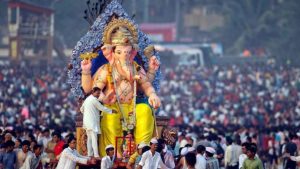


![Read more about the article Holiday List 2023 Download PDF [India] Government and State Holidays](http://3.219.171.151/wp-content/uploads/2023/01/blog-covers-2240-×-1500px-47-2-300x174.webp)